The large mayflies are a summer phenomenon, but it might be worth reading up on off season.
In the beginning of the summer, big mayflies are getting every fish in the stream to rise to the surface – and causing anglers to call in sick from work.
It's the green drake hatch!
When these large insects are on the water, all the really big fish come to life. Even the big trout usually chasing minnows or feeding at night, will rise for them because they are so big and juicy. It's a small surprise that the green drake hatch has such an important place in the fly fishing list of seasonal "events".
History
The first known appearance of the term "drake" was in Dame Juliana Berners’s (1496) "Treatyse of Fysshynge with an Angle". The book uses the term "drakes” to describe fly patterns constructed by using feathers from a male duck. The next recorded tribute to the green drake comes from Charles Cotton, in the fifth edition (1676) of Waltons "The Compleat Angler"
- "... of all these (and I have named you a great many very killing flies) none are fit to be compared with a Drake and Stone-fly, both for many and very great fish ..."
Charles Cotton Green Drake Recipe (No.35)
- Tying thread: Green or rather yellow waxed with green wax
- Tail: Sable or fitch tail
- Body: Camels hair, bright bears hair, the soft down combed from a hog's bristles and yellow camlet mixed, the body long
- Rib: Green silk or rather, yellow silk waxed with green wax
- Wing: White grey mallard dyed yellow
- Hook Size: 8-10 2x long
The Name
The origin of the word "drake” is in the Greek word dragon, but in English it can also be duck male and in parts of the United Kingdom, the drake name is applied to any mayfly.
What is a green drake?
The right answer depends on where you live. Or where you fish. Generally, one can say, it is an Emerger and Dun stage of a large mayfly species, green, pale olive or greenish in color. Like most common names, the "Green Drake" term can refer to more than one creature. It will probably be suitable for about 10-15 species and sub-species worldwide.
American anglers encounter two totally different green drake mayflies: the Eastern Green Drake (Ephemera guttulata) and the Western Green Drake (Drunella grandis). They are not really related to each other.
On the other side of the pool, in Europe, the large mayfly commonly called the green drake will be the Ephemera Danica. This European green drake and the American Eastern Green Drake share many similarities like they are burrowers as nymphs, have similar colors and the same size.
But are other green drakes like "The Hex" (Hexagenia Limbata), the Dark Green Drake (Litobrancha Recurvata), Drunella doddsi, Drunella grandis flavicincta, Drunella grandis grandis, Ephemera lineata and more.
Why green? This color is inherited from insect hemolymph – insect blood. Hemolymph is clear or tinged with yellow or green. It fills all of the interior (the hemocoel) of the animal's body and surrounds all cells. It contains hemocyanin, a copper-based protein that turns blue-green in color when oxygenated. When not oxygenated, hemocyanin quickly loses its color and appears grey. Terrestrial insects, as well as mayfly imagos (adults), have a system of tubes that transports gasses directly between their cells and the outside air, so they don't use hemolymph for transporting oxygen. That is probably, why the "Green Drake" becomes the "Grey Drake".
Lifecycle
Because we deal with several species, I will stay with a rough description of a green drake life cycle.
Nymph
Most of the Green Drake nymphs are big, living in burrows in the sandy mud of flowing or still waters. They are light in color and have rounded bodies with movable gills on the abdomen, which they use to force water through the burrow. There are some, which differs, like the Western Green Drake (more later).
Emerger
When mayfly nymphs start emerging, air and gases start collecting under their skin (exoskeleton), which pulls them up to the surface. During molting, nymphs don’t breath. They start molting underway to the surface. Mayflies in the molting phase are called Emergers. Their exoskeleton splits along the back and they pull themselves out and spread up their wings.
Dun (Subimago)
The nymph emerges into an adult called a Dun (Subimago) that has a pale olive color and dull-colored wings. The mouth parts are non-functional as adults do not feed. They float on the water surface and wait for the veins in their wings to fill with fluid. Once ready to take off, they will seek shelter on the trees and vegetation near the stream. At this point they are still sexually immature, and will have to go through another molting to become a mature imago.
Spinner (Imago)
The second molting of an adult mayfly is very unique. It is a transformation from a Dun (Sub-imago) to a Spinner (Imago), which will be slightly smaller, more slender and with clear, transparent wings. Finally our creature is ready to mate.
Spent
Spinners mate in flight above the stream. After mating, the females will lay eggs in the water. This process is exhausting to death. When the females die, they fall on the water surface in the spent position. This usually happens in the dusk or the dawn. Male spinners mostly fly off to the shore where they die, so most spent mayflies found on the water surface will be females.
Tereza Ščerbová
Eastern Green Drake – Ephemera guttulata
Their body length averages 32 mm and their tails are about as long as their abdomen. The color of their wings in the dun stage is a pale yellow with dark venation. Their thorax, underbody and legs are cream colored and the top is grey/brown. They have three black tails. The males are smaller than the females, and both genders vary greatly in size. You should size your flies based on local naturals.
Their hatch doesn’t last very long and often takes place late in the evening. Eastern Green Drakes usually emerge during the first week of June, but this time frame can vary with the weather and elevation. The hatch timing is also different on different rivers. Nymphs swim to the surface and emerge from their shucks very quickly, but luckily the duns take a long time to get off the water. Within several days, duns transform into the spinners. Spinners' bodies and tails gain some length compared to the duns, and they are thinner, wings more fine and transparent. Spinners return to mate about three days after emerging as duns.
Once the swarms begin, it is almost positive that great fishing will follow.
The spinner stage of the insect is still called the Coffin Fly, after the fly designed by Walt Dette and Ted Townsend, the day in 1930 Townsend attended a funeral, inspired by the dominant colors of clothing at the funeral, black & white.
Western Green Drake – Drunella grandis (grandis, doddsi, g.flavitincta, g.grandis...)
Color and size variations exist from stream to stream. Three tails, dark gray wings with bright olive green body. The body quickly darkens to dark olive or brown after emergence. The hatches take place in June into early July. Duns normally emerge during the late mornings. Spinners fall early in the morning. The best activity occurs on cloudy humid days. Western Green Drake nymphs are not burrowers like the Easterns are. They fall into the crawler category of mayflies. It is also obvious when seeing their body shape, structure and color. Flat, wide, brown or green.
Also instead of emerging rapidly like the Eastern burrowers, the Western crawlers make multiple false starts between the bottom and the surface before finally emerging. They begin by crawling along the bottom to shallower water, followed by several swims to the surface. That makes them more interesting for trout. Once they are free from their nymphal shuck, they wait motionless on the surface for their wings to expand and fill. Then they take off towards nearby trees and vegetation.
Other subspecies in the Drunella genus, such as D. flavilinea, may be called Little Green Drakes. But Westerners call them "flavs,” and they hatch later in summer.
The Hex - Hexagenia limbata
The mature adult stage of Hexagenia limbata can be as much as 40 mm long! The nymphs burrow in mud, in lakes and slow-moving rivers. It is the most widely distributed mayfly in North America, known from most of Canada and all the states in the US except Alaska, Arizona and New Mexico.
Most of the waters with massive Hex hatches are too warm for trout, but some fecund limbata hatches occur in trout water in California, Oregon, the driftless area of Wisconsin and other southerly trout waters. The hatch can be highly synchronized, resulting in a massive emergence.
The Hex hatch begins in early June. Duns are not so green, but can still be considered as a Green Drake.
Dark Green Drake - Litobrancha Recurvata
This is another burrowing nymph mayfly. It takes two to three years to mature. It is one of the largest North American mayfly species. Its distribution is mostly eastern, living in slower streams and lakes. Hatching takes place from late May to July. It's not a common mayfly, but where it is found, it produces pretty big hatches, mainly during dusk.
Hatches typically only last for about week on a given stream. Litobrancha has a slow emergence and very often ends as cripples. These mayflies return as spinners one to three days after hatching creating massive synchronized spinner falls.
There's a great video with Litobrancha emergence from "Biologist Angler"
European Green Drakes - Ephemera danica (Ephemera lineata, vulgata, glaucops...)
This species is commonly found in clear watered rivers and lakes with sand or gravel bottoms throughout Europe and the British Isles. The deeper regions with more mud, and slightly slower flow rates seem to be the area they like best. But they can be found in streams with just little silt pockets on the side of the current. The name of the American species was inherited from this "Mother of Green Drakes".
Nymphs can grow up to 30mm and are mostly cream in color. They have three tails and gills on the sides of their abdomen. The nymphs dig into the gravel to form a tubular burrow, and they use their gills to force the water through this burrow. They feed by filtering and collecting fine particles of organic detritus. Ephemera danica usually has a two year life cycle, but recent work has shown that in the warmer waters it is able to complete its life cycle in one year.
Emergence of the adults takes place during daylight (midday hatch), but can vary from late morning to mid afternoon depending on weather conditions. On a cold, cloudy day, the hatch can be an evening affair, sometimes lasting until dusk.
The emerging Danica is probably one of the quickest mayflies to break the water film. In damp weather the process is a bit slower. But newborn Green Drake duns can stay for a pretty long time on the surface, waiting for their wings to fill and stretch. That luckily makes them easy prey for marauding trout, which feed upon them with pleasure.
The sub-imago has grey wings, with a yellowish green tinge and heavy venation. The body is creamy yellow with distinctive brown markings on the body segments. The tails are dark grey to black and the legs are a creamy olive color. The biggest emergence occurs in May to early June. Adults can, however, be present between April and November.
Females imago are 20–30 mm and males are smaller. The imago has transparent wings, which have heavy brown venation and several dark patches. The body is creamy white with the last three segments brownish. The tails are extremely long and almost black in color.
Fishing
When the first adult Green Drakes of the day break the surface, trout will be already feeding on the nymphs.
If fish are visibble in the surface, a dorsal fin breaking the water now and then, the fish are taking subsurface nymphs or emergers.
Trout will soon switch from hatching nymphs to duns. Use green drake cripples to represent the emerger or a crippled dun. Some trout in feeding frenzy will be feeding on all stages available at the same time.
Fishing with green drakes can be challenging, when so many real insects are on the water. The flies are also big enough to be inspected - and refused - by the trout. On the other hand, trout feeding frenzy is after all a frenzy and the fish aren't that picky. During the hatch the trout are also more aggressive. The fly can drift pretty far away from the fish and still be taken.
Credits
Author and videos Břetislav Kašpar
Illustrations Tereza Ščerbová
Photos Ben Lupton, Jan Hamrský & Kjell S. Rakkenes
Very rarely is the Green Drake considered an abundant mayfly, however, it doesn’t take large numbers of drakes to get trout feeding. Also these hatches do not last long, but give them a try even if the insects are not on the water anymore. Trout seem to keep a recollection of these large insects for several weeks after the hatch has ended for the year.
Green Drake hatches also move upstream. So if you see the hatch on one place, it might appear further upstream after a day or two, if the conditions are right.
While fishing with Green Drakes, is good to go upstream and avoid blind casting, but wait for rising fish, than cast to the rise.
Patterns
We need patterns to cover the full spectrum of the life cycle, including nymphs, emergers, cripples, duns, and spinners. Slow, clear water allows for a sparsely dressed fly. On faster water with a stronger current, add more CDC/Deer hair or hackles to make a high-floating and more visible fly. A key feature of a Green Drake dun and emerger is the green, pale olive sometimes even chartreuse color.
So, if someone tells you the green drakes are hatching, drop everything, grab fly rod and run! The potential is always for a most satisfying day on the stream.
My Youtube Playlist for "Mighty Green Drake" – Some Info and Tying patterns
- Log in to post comments

























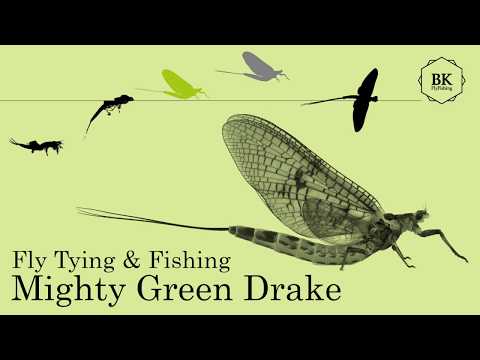
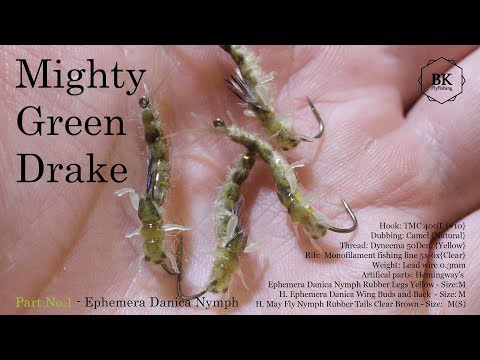
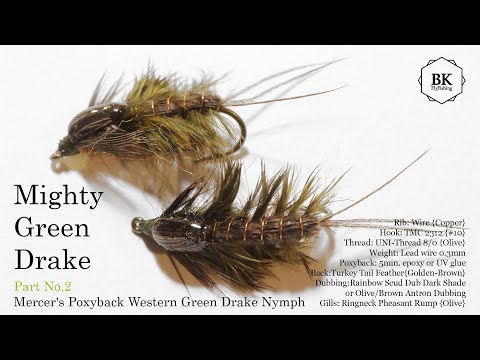
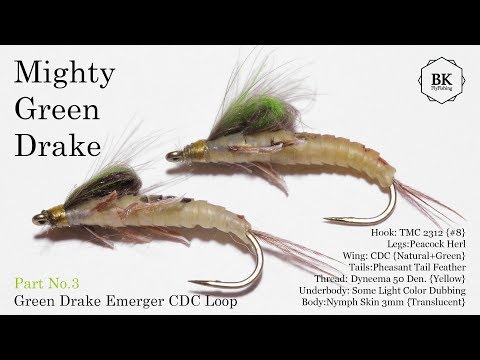
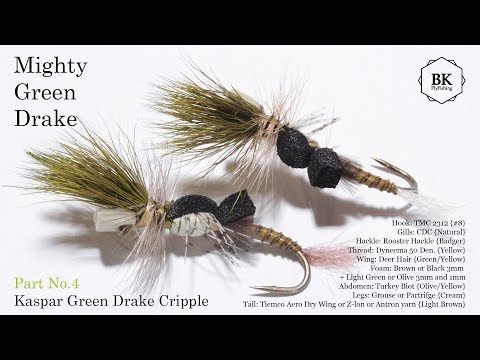
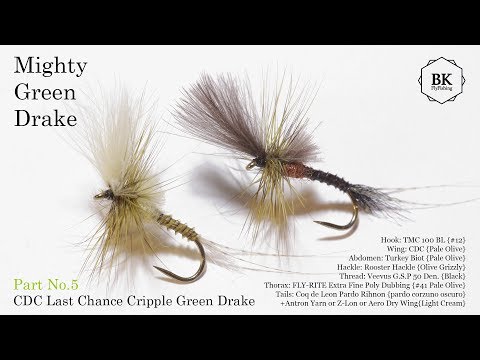
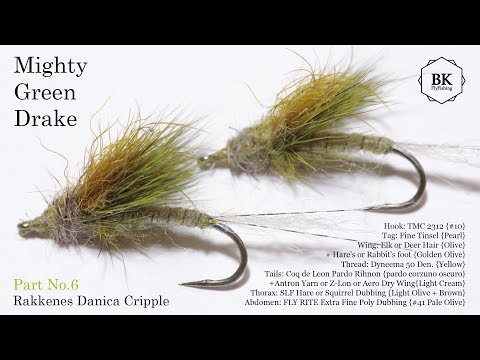
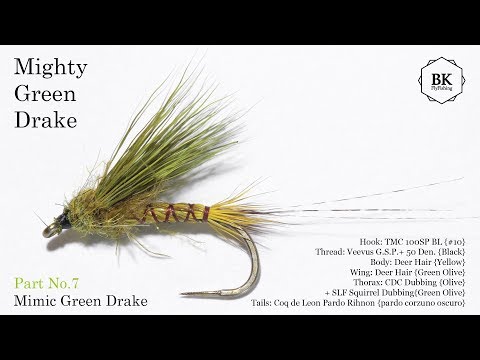
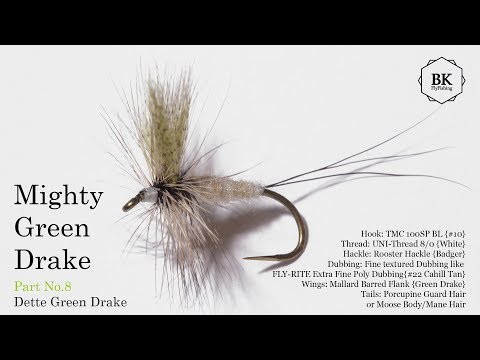
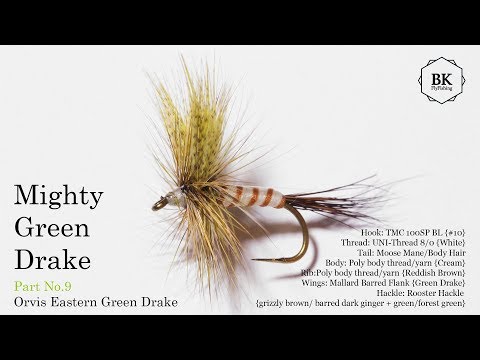
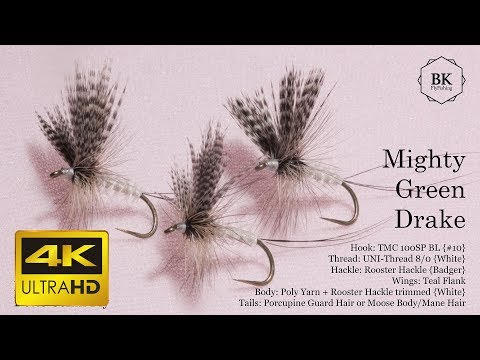
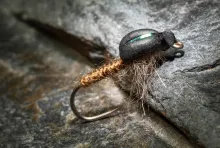


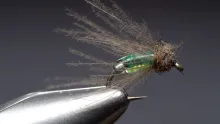
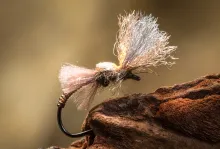
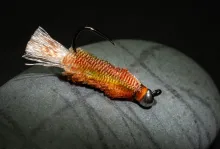

Green drake article
Very helpful and comprehensive article, complete with video links to fly tying of different life stages. Well worth a read, and book-marking this page.
Great article, nice drwings,
Great article, nice drwings, the last one interesting as potential tattoo idea. Thank you.